Quest Diagnostics Bundle
Who Does Quest Diagnostics Serve?
In the dynamic world of healthcare, understanding Quest Diagnostics SWOT Analysis is crucial for strategic success. The diagnostic information services industry is constantly evolving, driven by innovation and changing patient needs. This necessitates a deep dive into the company's customer demographics and target market to ensure alignment with current and future market demands.
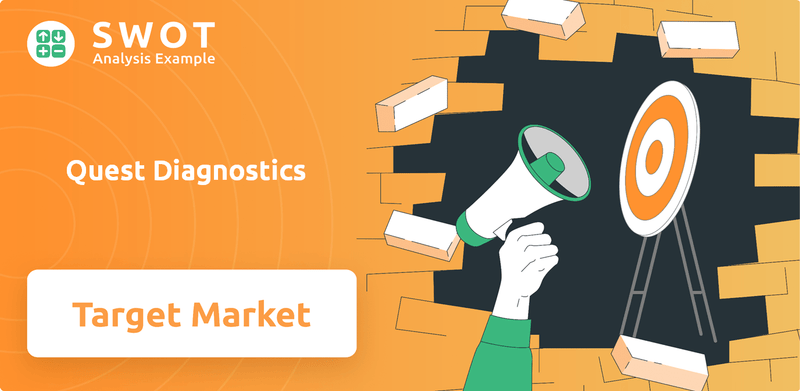
This detailed exploration delves into the customer demographics of Quest Diagnostics, examining the diverse groups it serves, from individual patients to healthcare providers. We'll analyze the company's target market segmentation, considering factors like age range, income levels, geographic reach, and specific health conditions. By understanding the patient profile and conducting thorough market analysis, we can gain valuable insights into diagnostic testing trends and opportunities for Quest Diagnostics.
Who Are Quest Diagnostics’s Main Customers?
Understanding the customer demographics and target market of Quest Diagnostics is crucial for grasping its market position. The company operates in both Business-to-Consumer (B2C) and Business-to-Business (B2B) segments, serving a diverse range of customers. This dual approach allows Quest Diagnostics to cater to various healthcare needs and market dynamics.
In the B2C sector, individual patients represent a significant portion of the target market. These individuals seek direct access to diagnostic testing for various health reasons, including routine check-ups and chronic disease management. The B2B segment includes healthcare providers, hospitals, managed care organizations, and employers, each utilizing Quest Diagnostics' services for different diagnostic and health-related needs.
Quest Diagnostics' comprehensive services cater to a broad spectrum of individuals and organizations. This wide reach is supported by its extensive network and advanced testing capabilities, making it a key player in the diagnostic testing industry. For more insights into the company's financial performance, consider exploring resources like the analysis of Owners & Shareholders of Quest Diagnostics.
This segment includes individuals of all ages, genders, and income levels. They seek services for health monitoring and specific diagnostic needs. The demand for consumer-initiated testing is increasing, reflecting a shift towards greater patient control over healthcare.
General practitioners, specialists, and independent practices rely on Quest Diagnostics for diagnostic tests. These tests aid in diagnosis, treatment monitoring, and disease prevention. This segment represents a core customer base for the company.
Hospitals and integrated networks utilize Quest's services for inpatient and outpatient diagnostic needs. They leverage the company's extensive test menu and operational scale. This segment benefits from Quest's comprehensive testing capabilities.
These organizations partner with Quest Diagnostics to provide cost-effective diagnostic services to their members. They focus on delivering high-quality care while managing costs. This segment is crucial for value-based healthcare.
Quest Diagnostics serves a diverse range of customers, including individual patients, physicians, hospitals, and managed care organizations. The company's market analysis indicates a growing demand for direct-to-consumer testing and precision medicine solutions. Understanding these segments is vital for strategic planning.
- Customer demographics span all age groups, genders, and income levels.
- The patient profile includes individuals seeking routine health monitoring and specialized diagnostics.
- Healthcare providers rely on Quest for a comprehensive range of clinical laboratory tests.
- Employers utilize services for employee health programs and wellness initiatives.
Quest Diagnostics SWOT Analysis
- Complete SWOT Breakdown
- Fully Customizable
- Editable in Excel & Word
- Professional Formatting
- Investor-Ready Format
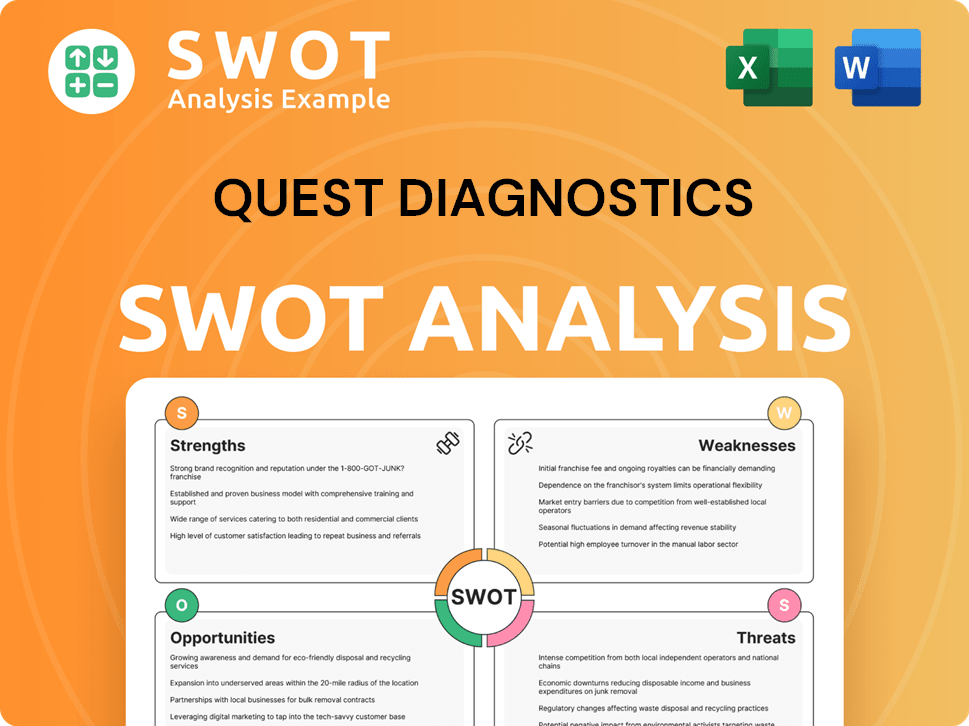
What Do Quest Diagnostics’s Customers Want?
Understanding the needs and preferences of customers is crucial for any business, and for a company like Quest Diagnostics, this involves catering to both healthcare providers and individual patients. The company's success hinges on meeting the diverse requirements of these two primary customer groups. Analyzing these needs provides insights into how Quest Diagnostics can enhance its services and maintain its market position.
The key drivers for Quest Diagnostics' customers include accuracy, timeliness, convenience, and the ability to gain actionable insights from the test results. Healthcare providers need reliable and prompt results to make informed decisions, while patients prioritize ease of access and understandable information. This dual focus shapes the company's service offerings and marketing strategies.
Quest Diagnostics' focus on customer needs and preferences is essential for its success. By understanding the demands of both healthcare providers and individual patients, the company can tailor its services, improve customer satisfaction, and maintain its competitive edge in the diagnostic testing market.
Physicians and healthcare providers require accurate and timely test results to facilitate diagnoses and treatment plans. They rely on the breadth of the test menu, quality assurance, efficiency of specimen handling, and expert consultation. The use of digital platforms for ordering and result access is increasingly preferred.
Individual patients prioritize convenience, accessibility, and clear communication of results. They seek easily accessible service centers, streamlined appointment scheduling, and understandable explanations. The desire for peace of mind and proactive health management are key motivators.
Patients are often driven by a need for reassurance or a proactive approach to health. Avoiding long wait times and minimizing out-of-pocket expenses are also significant factors. The company addresses these needs by providing extensive network coverage and user-friendly online portals.
Quest Diagnostics addresses pain points by offering an extensive network to reduce travel burdens and user-friendly online portals for result access. These initiatives enhance the patient experience and improve overall satisfaction. The company's focus on convenience and accessibility is crucial.
Market trends, such as telemedicine and at-home testing, influence Quest Diagnostics' product development. This has led to initiatives like expanded phlebotomy services and direct-to-consumer testing options. The company adapts to these changes to meet evolving customer needs.
Quest Diagnostics tailors its marketing to different audiences. For healthcare professionals, it highlights its extensive network and advanced testing capabilities. For individual consumers, it emphasizes convenience and empowers health insights. This targeted approach helps to reach and engage each customer segment effectively.
Understanding customer behavior is essential for Quest Diagnostics. The company conducts market analysis to understand patient demographics and preferences. This includes analyzing factors like age range, income levels, and geographic reach to tailor services effectively. The goal is to improve customer satisfaction and loyalty.
- Customer Demographics: Quest Diagnostics serves a wide range of customers, including various age groups, from children to seniors. The customer age range is broad, reflecting the diverse needs for diagnostic testing.
- Patient Profile: The patient profile includes individuals with various health conditions, from routine check-ups to specialized testing for complex cases. Understanding the customer health conditions helps in providing targeted services.
- Geographic Reach: Quest Diagnostics has a broad geographic reach, with services available across the United States. This extensive network ensures accessibility for a large number of patients.
- Market Analysis: Market analysis is critical for understanding trends and opportunities. This includes analyzing market share analysis and competitor analysis target market to stay competitive.
Quest Diagnostics PESTLE Analysis
- Covers All 6 PESTLE Categories
- No Research Needed – Save Hours of Work
- Built by Experts, Trusted by Consultants
- Instant Download, Ready to Use
- 100% Editable, Fully Customizable
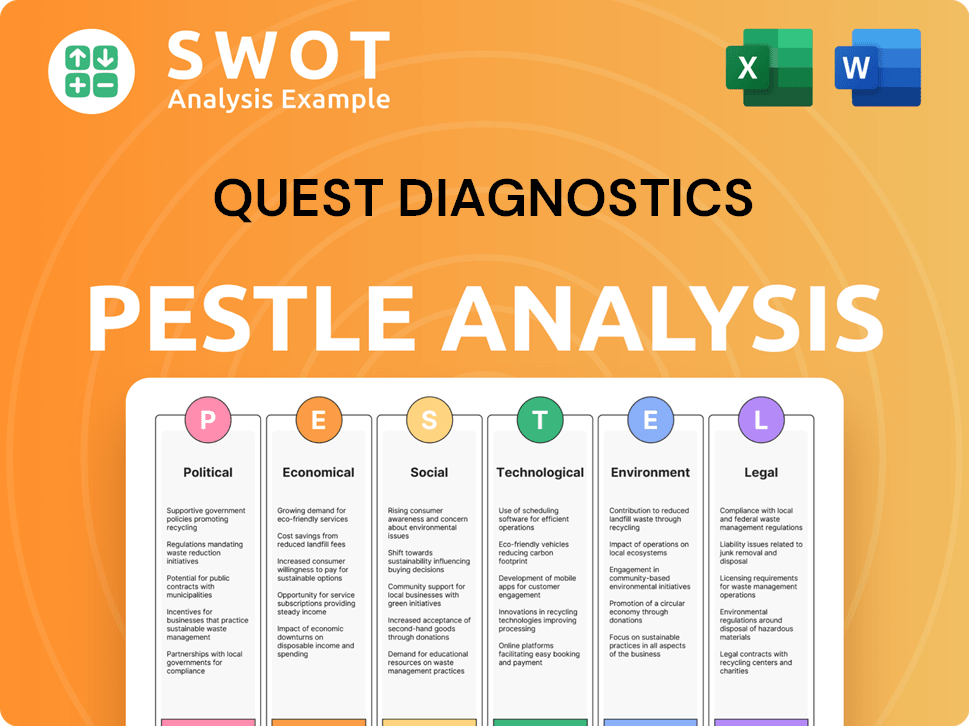
Where does Quest Diagnostics operate?
The geographical market presence of Quest Diagnostics is primarily centered in North America, with a strong emphasis on the United States. The company has a broad reach across all 50 states, serving a vast network of physicians, hospitals, and patients. This extensive presence allows for widespread access to diagnostic testing services, making it a key player in the healthcare sector.
Major markets for Quest Diagnostics within the U.S. include densely populated metropolitan areas. These areas typically have robust healthcare infrastructures and high demand for diagnostic services. The company strategically places patient service centers in accessible locations to cater to these populations. This strategic approach ensures that services are readily available to a diverse range of customers.
Differences in customer demographics and preferences are evident across various regions. For instance, areas with a higher concentration of elderly populations may see greater demand for chronic disease monitoring. In contrast, younger, urban populations might show a higher interest in wellness testing. Quest Diagnostics adapts its offerings to meet these varied regional needs, ensuring that its services remain relevant and accessible to all segments of the population.
Quest Diagnostics holds a significant market share in the U.S. diagnostic testing market. The company's services are utilized by a wide range of healthcare providers and patients nationwide. Its extensive network includes thousands of patient service centers and laboratories, ensuring broad accessibility.
Customer demographics and preferences vary across regions, influencing the demand for specific diagnostic services. For example, areas with older populations may require more chronic disease management tests. Younger populations might seek wellness and preventative testing. These regional differences are addressed by tailoring services and marketing efforts accordingly.
Quest Diagnostics focuses primarily on the U.S. market, with strategic expansions aimed at deepening its penetration and service capabilities. The company analyzes geographic sales data to optimize resource allocation and identify growth opportunities. This targeted approach allows for efficient service delivery and market expansion.
Quest Diagnostics offers direct-to-consumer diagnostic solutions, expanding its reach to a broader customer base. This includes wellness testing and other services that can be accessed directly by consumers. The company’s direct-to-consumer services are designed to provide convenient and accessible healthcare solutions.
Quest Diagnostics' customer base is diverse, encompassing various age groups, income levels, and health conditions. The company provides services for a wide range of medical needs, from routine check-ups to specialized testing for specific diseases. Understanding the Revenue Streams & Business Model of Quest Diagnostics can provide further insights into how the company caters to its diverse customer segments and optimizes its market strategies. The company's ability to adapt to regional healthcare trends and needs is a key factor in its continued success.
Quest Diagnostics Business Model Canvas
- Complete 9-Block Business Model Canvas
- Effortlessly Communicate Your Business Strategy
- Investor-Ready BMC Format
- 100% Editable and Customizable
- Clear and Structured Layout
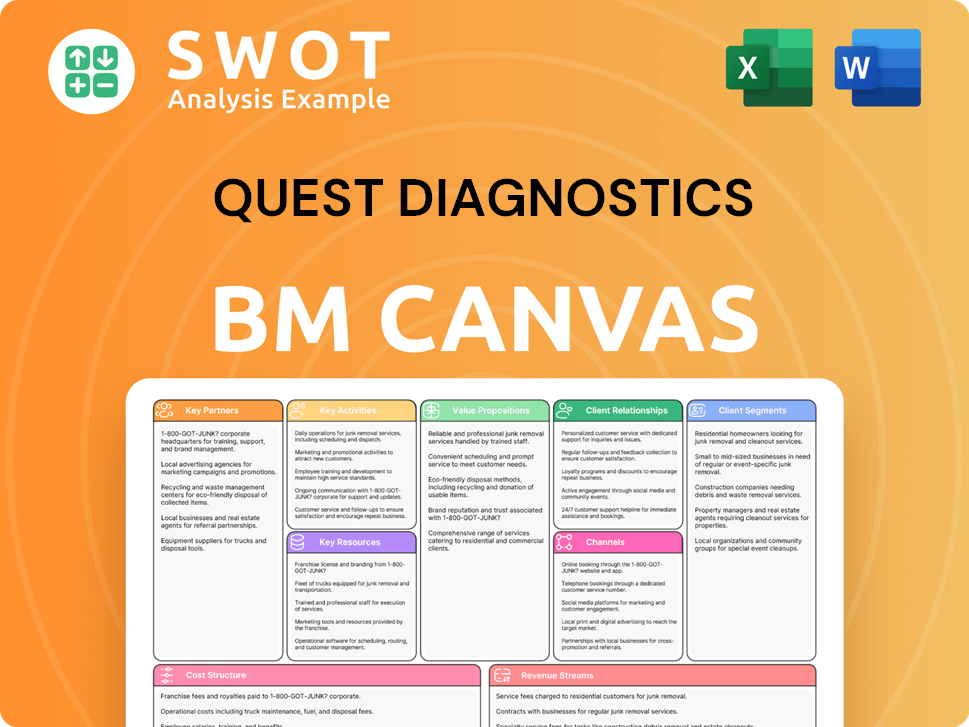
How Does Quest Diagnostics Win & Keep Customers?
Customer acquisition and retention strategies at Quest Diagnostics are multifaceted, targeting both healthcare providers and individual patients. The company leverages a mix of traditional and digital marketing, direct sales, and strategic partnerships to attract new customers. A strong emphasis on customer service, technological integration, and data-driven insights is central to retaining existing clients and fostering long-term relationships. These strategies are continuously refined to adapt to evolving market dynamics and customer preferences.
For healthcare providers, acquisition involves direct sales teams, industry conferences, and targeted digital advertising. Retention efforts focus on consistent quality, reliable service, and seamless integration with electronic medical records (EMRs). Individual patients are acquired through physician referrals, direct-to-consumer advertising, and partnerships, with digital marketing and convenient patient service centers playing key roles. Retention strategies for patients include user-friendly online portals, clear communication of results, and initiatives like the Quest Diagnostics app.
The use of customer data and CRM systems is crucial for segmenting customers and personalizing communications. Data analytics inform targeted campaigns for specific health screenings or chronic disease management programs. Successful acquisition campaigns highlight new testing capabilities, while retention initiatives focus on building trust and demonstrating value. The company has increased its focus on digital engagement and consumer empowerment, positively impacting customer loyalty and lifetime value. For a deeper understanding of the company's growth strategies, consider reading about the Growth Strategy of Quest Diagnostics.
Direct sales forces engage with physician practices, hospitals, and managed care organizations. Marketing includes industry conferences and medical journals. Digital advertising emphasizes clinical excellence and operational efficiency.
Focus on consistent quality and reliable service is key. Provide ongoing support, including educational resources. Seamless EMR integration enhances the customer experience.
Reliance on physician referrals and direct-to-consumer advertising. Strategic partnerships with health systems and employers are crucial. Utilize digital marketing, including SEO and social media.
Offer user-friendly online portals for appointment scheduling. Provide easy access to test results. Utilize initiatives like the Quest Diagnostics app for health information management.
Customer data and CRM systems are used to segment customers. This enables personalized communications. Tailored service offerings are developed based on segmentation.
Data analytics inform targeted campaigns. Campaigns focus on specific health screenings. They also address chronic disease management programs.
Highlighting new testing capabilities is important. Emphasizing improved patient experiences is also a focus. These campaigns drive new customer acquisition.
Building trust is a key retention strategy. Demonstrating value through high-quality service is also important. Convenient access to diagnostic information enhances loyalty.
Increased emphasis on digital engagement is a recent trend. Consumer empowerment is also a focus. This has positively impacted customer loyalty.
The diagnostic testing market is experiencing growth. Telehealth and remote patient monitoring are increasing. Personalized medicine is becoming more prevalent.
Quest Diagnostics Porter's Five Forces Analysis
- Covers All 5 Competitive Forces in Detail
- Structured for Consultants, Students, and Founders
- 100% Editable in Microsoft Word & Excel
- Instant Digital Download – Use Immediately
- Compatible with Mac & PC – Fully Unlocked
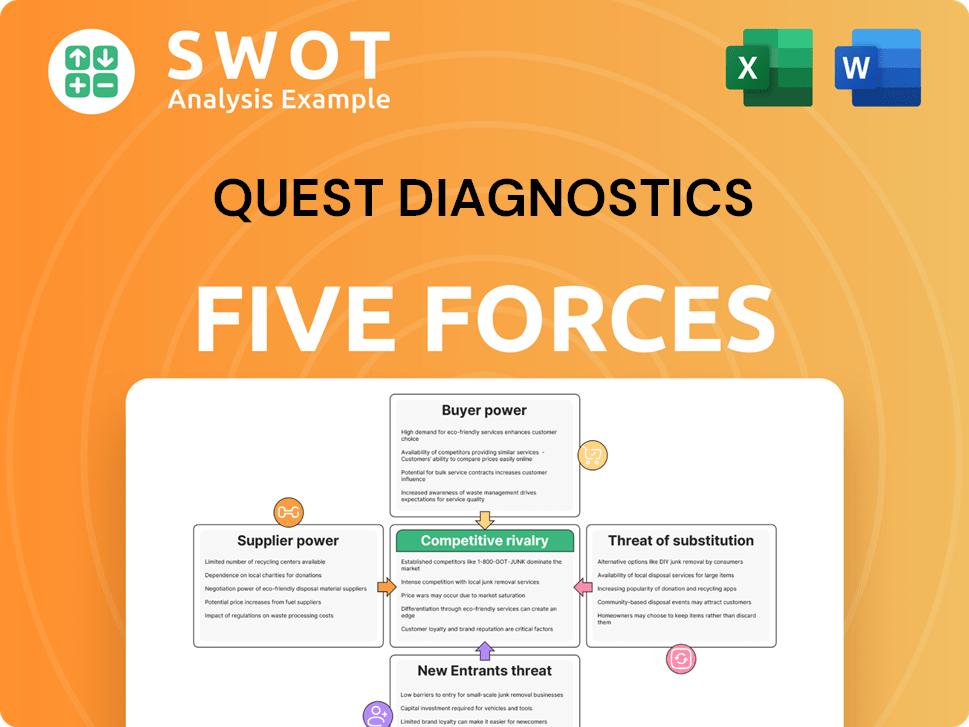
Related Blogs
- What are Mission Vision & Core Values of Quest Diagnostics Company?
- What is Competitive Landscape of Quest Diagnostics Company?
- What is Growth Strategy and Future Prospects of Quest Diagnostics Company?
- How Does Quest Diagnostics Company Work?
- What is Sales and Marketing Strategy of Quest Diagnostics Company?
- What is Brief History of Quest Diagnostics Company?
- Who Owns Quest Diagnostics Company?
Disclaimer
All information, articles, and product details provided on this website are for general informational and educational purposes only. We do not claim any ownership over, nor do we intend to infringe upon, any trademarks, copyrights, logos, brand names, or other intellectual property mentioned or depicted on this site. Such intellectual property remains the property of its respective owners, and any references here are made solely for identification or informational purposes, without implying any affiliation, endorsement, or partnership.
We make no representations or warranties, express or implied, regarding the accuracy, completeness, or suitability of any content or products presented. Nothing on this website should be construed as legal, tax, investment, financial, medical, or other professional advice. In addition, no part of this site—including articles or product references—constitutes a solicitation, recommendation, endorsement, advertisement, or offer to buy or sell any securities, franchises, or other financial instruments, particularly in jurisdictions where such activity would be unlawful.
All content is of a general nature and may not address the specific circumstances of any individual or entity. It is not a substitute for professional advice or services. Any actions you take based on the information provided here are strictly at your own risk. You accept full responsibility for any decisions or outcomes arising from your use of this website and agree to release us from any liability in connection with your use of, or reliance upon, the content or products found herein.